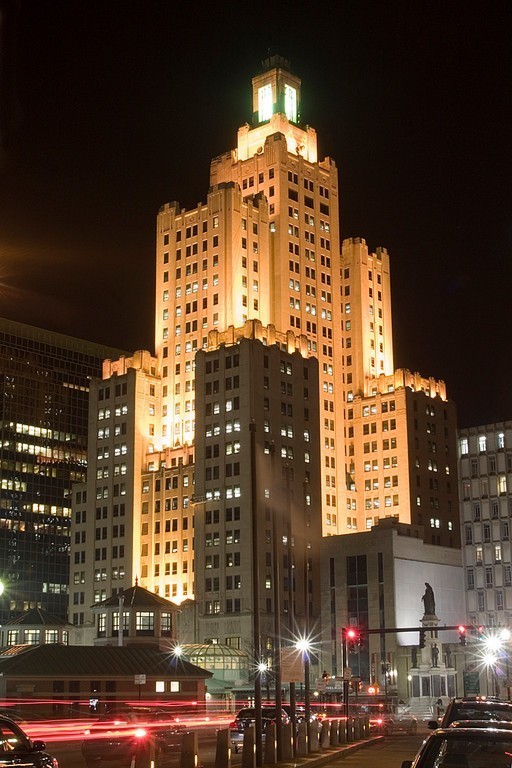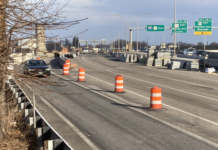
The thought of Providence’s tallest building empty and the bright beacon at its pinnacle dark is unsettling to many working on the city’s revitalization. But local real estate analysts say Bank of America’s impending departure from 111 Westminster St. may not be as bad for the health of the financial district as some fear.
After all, sole tenant Bank of America says it has no plans – for now – to reduce the size of its Providence workforce. And the company is actively searching for 50,000 square feet of downtown office space for those employees in 111 Westminster St. who aren’t moved to other Bank of America offices nearby.
“I don’t think it is going to have a huge impact on the market,” said Karl Sherry, partner at Hayes & Sherry Real Estate Services, which lists space in several buildings. “Relative to the size of the building, I don’t think it would have that much impact because they are taking other space in downtown, so they would be going from one building to fill another vacant space. The impact would be that you would have a landmark building vacant.”
Kenneth Dill of CresaPartners Providence, which represents commercial tenants in the office market, said the impact of Bank of America’s departure on the rest of the market would depend on what 111 Westminster’s owner, High Rock Westminster LLC, decides to do with the building.
“If it is not multitenanted, I don’t think it has much effect on the rest of the market,” Dill said. “Right now it is only relevant if you are a 350,000-square-foot user, and I don’t know how many of those there are around.”
Whatever plans High Rock has for 111 Westminster, the Wellesley, Mass., real estate investment firm is not saying publicly.
“We have a company policy not to comment on any of our assets,” said David Sweetser, managing partner of High Rock Development, when reached by phone.
According to Bank of America officials, High Rock did not submit a proposal for 111 Westminster in response to Bank of America’s December request for proposals for 50,000 square feet of office space in the city.
Built in the Art Deco style by Industrial Trust in 1928, 111 Westminster St. has been known locally as the “Superman” building since the 1950s for its resemblance to the Daily Planet headquarters in the Superman television and comic-book series. (The building also has an address of 55 Kennedy Plaza for its north-facing entrance.)
High Rock bought the building in early 2008 for $33 million, according to assessor’s records that place a current appraised value on the property of $31,334,500. The current annual property tax bill is about $1 million.
Documents filed with the Providence Recorder of Deeds indicate High Rock took out a $23 million mortgage from Boston Private Bank & Trust Co. on 111 Westminster St. in February 2008.
Although the building has had multiple tenants over the decades, it is currently set up for a single user, with an older heating and cooling system that doesn’t allow it to be easily subdivided.
Bank of America employs 3,000 people in Rhode Island, but only a fraction of them work in 111 Westminster. Bank of America has declined to say how many of its employees are located in 111 Westminster, but city officials have said it is about 400 people.
As expected, Bank of America at the end of January declined its option to renew the lease and announced that it would instead consolidate its workforce in some of the other offices it leases nearby that include 1 Financial Plaza, 1 Citizens Plaza and 100 Westminster St., as well as 167,000 square feet in East Providence.
“This was a decision any responsible company would make,” said Bank of America spokesman T.J. Crawford about the decision to consolidate and shed empty space. Since the recession, the Charlotte, N.C.-based banking giant has been reducing its footprint in similar ways across the country.
In addition to the upstairs offices, Bank of America has also decided to move the retail branch from its current 17,000-square-foot, ground-level space in 111 Westminster to an as yet undetermined, nearby location “more in line with the 3,000-square-foot industry standard,” Crawford said.
Asked whether Bank of America had considered keeping some of its workers in 111 Westminster, Crawford said the bank had, but High Rock showed “an understandable reluctance to break up the building.”
According to CB Richard Ellis New England, the vacancy rate for downtown commercial office space in 2011 was 15.9 percent, down from 18.9 percent in 2010, as 172,000 square feet of space was absorbed during the year. By the end of the year, there was 997,000 square feet of “available” space downtown, the CB Richard Ellis report said, but that figure did not include space in buildings like 111 Westminster St. that were under lease but unused.
At the firm’s annual market-overview conference on Jan. 5, CB Richard Ellis New England Partner and Senior Vice President Alden Anderson said the market in Rhode Island had reached a turning point in 2011 and predicted demand would increase in 2012.
Citing his firm’s ongoing relationship with Bank of America, Anderson declined to comment on the impact of the bank’s departure from 111 Westminster St.
Of course much, if not most, of the concern about Bank of America’s departure from 111 Westminster is connected to the building’s symbolic significance and the psychological affect an empty “Superman” building would have on the city.
Providence Mayor Angel Taveras, who sees the top of the tower from his office window in City Hall, made keeping the building occupied a priority and assigned Economic Development Director James Bennett to work with Bank of America and High Rock on the issue.
Two days after Bank America announced its intention to leave 111 Westminster, Bennett said the decision would now intensify his efforts to coax another anchor tenant to the building.
“It was not unexpected,” Bennett said. “The good news is there is some demand. We are starting to get some saturation in class A space. [The Bank of America building] would be class B teetering on class C, but this is the most bullish [potential occupants] have been on downtown in a while.”
While High Rock has not ruled out breaking the building up, Bennett said, his focus remains trying to find a large anchor user, which could indicate the owners are not on the verge of making large changes or converting the building to some other use.
“What we are looking for is a big user and then backfill some of the rest,” Bennett said, noting that estimates of the cost of modernizing the building have been in the neighborhood of $25 million.
“The best thing I can do is go out there and sell and sell,” Bennett said.
He said the city has not yet discussed with High Rock the matter of whether it will keep the tower lights on even if the building is empty, but it will do so and hopes to see the lights stay on.
“My sense is the people who own it are substantial and do not run away from their problems,” Bennett said. “I don’t think they are going to give the building back.”
The size of the investment needed to renovate or break up 111 Westminster St. has prompted many to suggest the government may have to get involved to keep the building from ending up in mothballs.
“In my mind it raises questions about what the government can do to attract a large user to downtown Providence,” said Dill at CresaPartners. “Another alternative is a major capital investment to multitenant the building. Is that a good investment for city/state government to make?”
For most people in the city, the question of who inhabits the “Superman” building and how much of the offices are empty is much less important than making sure the landmark tower is maintained and preserved.
Providence Preservation Society Executive Director James Hall said he was most concerned with the phenomenon known as “demolition by neglect,” where historic property owners put off by the cost of preserving important, old structures allow them to deteriorate until they have to be torn down.
“The longer the building goes unoccupied, the less attractive it is,” said Hall, who sees the ultimate future of the “Superman” building as mixed-use property with some residential component. He said the Rhode Island School of Design dormitory down the street at 15 Westminster could serve as a model.
In the meantime, Hall said the most important thing for the community was to keep the building intact and bright.
“I think we should be asking the owner to keep the lights on,” Hall said. “If the lights go out, that would have a deadening effect.” •












